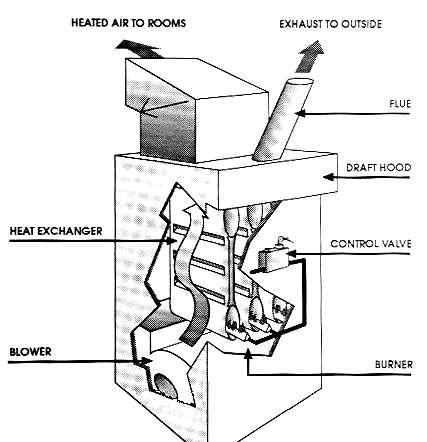Forced Air Gas Furnace: Difference between revisions
mNo edit summary |
mNo edit summary |
||
| Line 1: | Line 1: | ||
A gas forced-air heating system has a pilot light that ignites a burner inside the combustion chamber, creating heat that is then transferred to the furnace’s heat exchanger, a metal chamber around which air flows and is then heated. That heated air is then forced into the hot-air plenum and into the rooms through ducts. Gas fumes and carbon monoxide are vented through a flue in the roof. The forced air gas furnace provides the option for an attached air conditioning unit and humidifier. | A gas forced-air heating system has a pilot light that ignites a burner inside the combustion chamber, creating heat that is then transferred to the furnace’s heat exchanger, a metal chamber around which air flows and is then heated. That heated air is then forced into the hot-air plenum and into the rooms through ducts. Gas fumes and carbon monoxide are vented through a flue in the roof. | ||
The forced air gas furnace provides the option for an attached air conditioning unit and humidifier, part of a complete central air HVAC (Heating, Ventilating, and Air Conditioning) system. | |||
== Gas Furnace Diagram == | == Gas Furnace Diagram == | ||
Revision as of 11:06, 27 September 2010
A gas forced-air heating system has a pilot light that ignites a burner inside the combustion chamber, creating heat that is then transferred to the furnace’s heat exchanger, a metal chamber around which air flows and is then heated. That heated air is then forced into the hot-air plenum and into the rooms through ducts. Gas fumes and carbon monoxide are vented through a flue in the roof.
The forced air gas furnace provides the option for an attached air conditioning unit and humidifier, part of a complete central air HVAC (Heating, Ventilating, and Air Conditioning) system.
Gas Furnace Diagram
This type of furnace produces heat through the combustion of natural gas in the furnace's burner. The heat produced from this process then passes through a heat exchanger. Air from your home's return air ducts is blown over the heat exchanger, thus warming the air. The furnace's blower then blows the warmed air into the ductwork, which carries and disperses the warmed air throughout the home.
The Heat Exchanger
The heat exchanger on a furnace is the metal that separates the fire from the air stream. The heat exchanger was designed to keep the toxic fumes produces from burning gas separated from the clean heated air that is blown in your home. The inside of the heat exchanger allows the toxic flue gases produced from the burners to exhaust out through the furnace flue. The outside of the heat exchanger is where the cold air passes over, becomes warmed, and is blown throughout the ductwork of the home. The heat exchanger is the only wall separating the toxic flue gases from the supply air.
If a crack develops in the heat exchanger, there is a potential for carbon monoxide gas to leak over to the supply side and be blown throughout your rooms. Carbon monoxide gas is odorless. The human senses will not detect its presence. When the fan or blower is running it puts the outside area of the combustion chamber (heat exchanger) under positive pressure so there is no way the flue products could ever come out. Another problem with having a crack on one of these furnaces is that the flames will roll out because the draft air is leaking through the crack.
inspecting the heat exchanger
Visually examine the heat exchanger with the aid of a flashlight. Many furnaces will have hair line cracks in the metal and sometimes welds will pop and leave a tiny hole. Small holes may not pose a problem. Look for a significant breach in the heat exchanger. When the furnace comes in an flames roll through the cracks then it is a significant problem.
In your visual inspection consider.
1. Where is the crack? 2. How big is the crack? 3. How much air is leaking in out out of the crack? 4. Is the crack actually in the combustion area or in the sheet metal of the frame? 5. How will this crack affect the operation of the furnace? 6. How can this crack cause combustion products to leak into the living space? 7. Can you see light (blower removed) from the air side of the furnace? 8. How does the crack compare to the burner openings and the flue opening on each end of the heat exchanger?
